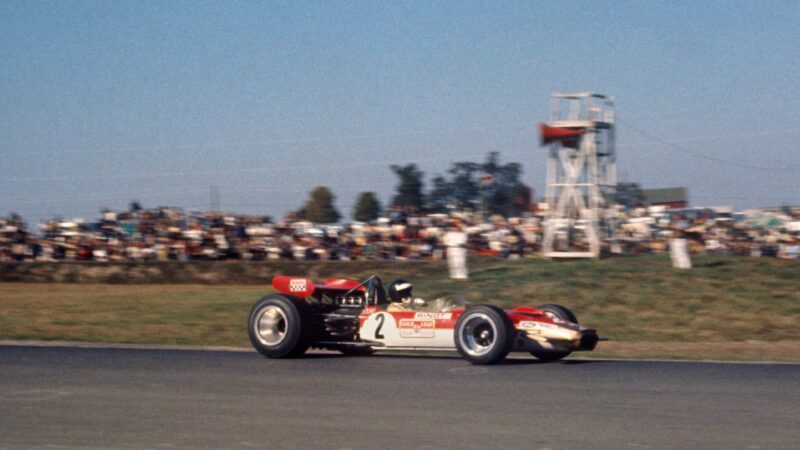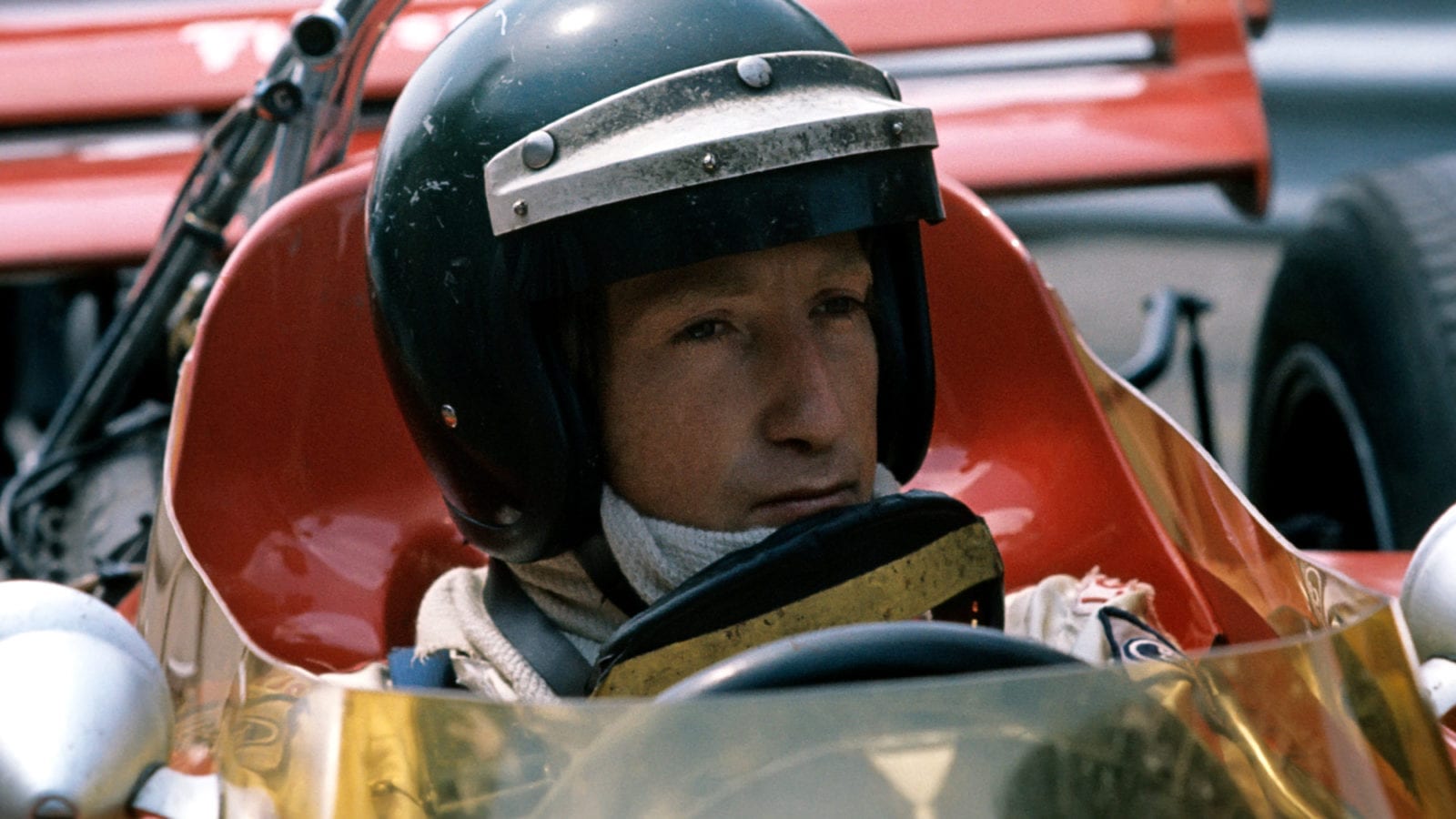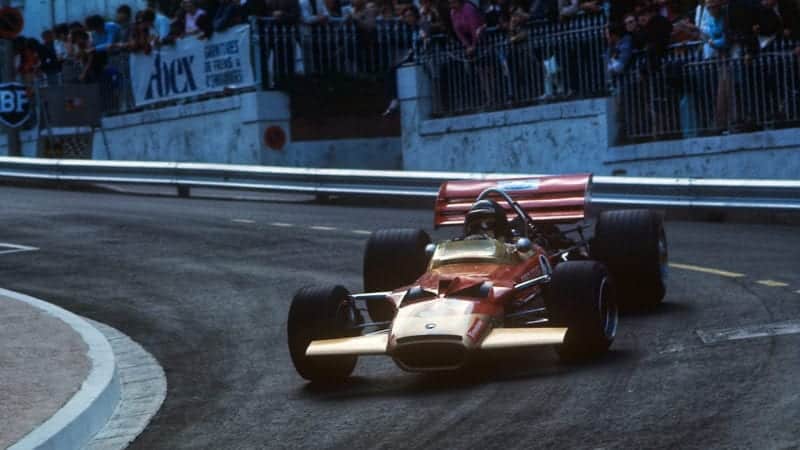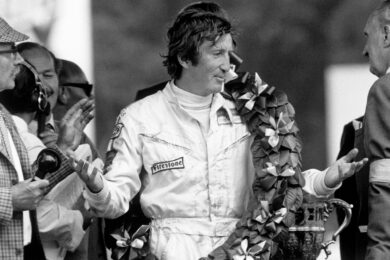The combination of the hard-bitten Rindt and mercurial Lotus boss Cohn Chapman amounted to the proverbial irresistible force meeting the immovable object. Chapman’s career in Formula I had gone hand-in-hand with the great Jim Clark’s rise to stardom: the two men had enjoyed a precious, closely sympathetic relationship and Clark had been dead for less than a year when the English team boss turned to Rindt. In Chapman’s mind, Jochen was quite simply the fastest man left in the business, but he was poles apart from Clark in terms of personality. Whereas Clark had been content simply to drive, Chapman suddenly found his new driver offering unwanted technical comments and criticisms. What’s more, Rindt being Rindt, these remarks were not wrapped up in any tactful dressing: the Austrian was blunt to the point of being downright offensive and it’s clear that Chapman, briefly, found himself virtually at war with his new recruit. The 1969 season was stormy and turbulent for the Lotus team, a succession of mechanical failures seemingly destined permanently to deprive Rindt from “breaking his duck” and winning that first, elusive Grand Prix triumph. Rindt should have won the 1969 British Grand Prix at Silverstone quite easily, all things being equal. His pole position Lotus 49B more than had the legs of Jackie Stewart’s Tyrrell Matra and the two cars quickly became embroiled in a frantic scrap for the lead. Rindt was clearly asserting himself when a rear aerofoil side plate worked loose and began dangling precariously close to one of the Lotus’s rear tyres. He made a quick stop for the offending side plate to be ripped away, but by the time he was back in the race Stewart was long gone: Rindt eventually finished fourth after another pit stop to top up with fuel. It was the lowest point of his relationship with Chapman who by that stage was so committed to the Lotus 63 4WD project that he’d actually sold the works 49Bs. Rindt demanded that he be given one of the old cars for Silverstone, so Chapman had to borrow one back from Jo Bonnier. “It’s like Barnum and Bailey’s circus in four separate rings!” remarked Jochen rather acidly to a colleage amidst Lotus’s British Grand Prix chaos. Later he warmed slightly to the Lotus 63 and agreed to drive it in the non-Championship Oulton Park race later in the season. He finished second to Jacky Ickx’s Brabham.
At the end of the season, at long last, Jochen Rindt won his first Grand Prix.

Rindt on the way to his maiden F1 win at Watkins Glen
GPLibrary/Universal Images Group via Getty Images
What’s more, in those days before Formula 1 prize funds were standardised, Rindt scooped the biggest prize in the business for his triumph in the United States Grand Prix at Watkins Glen. At last some of the dreadul luck that had run against him for so many seasons had turned in his favour. D.S.J. took out his rarely-used razor …
Notwithstanding Rindt’s success in that race, his personal relationship with Chapman was still pretty tempestuous and he seriously examined the possibility of returning to the more placid surroundings of the Brabham team for 1970. Black Jack made it quite public that he would consider retiring if Jochen returned to the fold, but at the end of the day there was no way in which Chapman was going to lose the quickest man in the business. The two individuals patched up their differences and did another deal for 1970, a deal helpfully massaged by Jochen’s astute friend and business manager Bernie Ecclestone, at that time on the fringes of motor racing once more after a decade away from the sport building up his other considerable business interests. For 1970, Colin Chapman had a demon new weapon up his sleeve, the superb torsion-bar sprung Lotus 72 which was destined to re-write the parameters of contemporary Grand Prix car performance in a manner so typical of the Lotus marque. Typically, Rindt was suspicious of its rather “fragile” appearance and told Chapman, initially at least, that he’d prefer to stick with the latest 49 development. Jochen started the European season with an archetypal Rindt race: mooning round for the first half of the Monaco Grand Prix in the middle of the field, the Austrian suddenly scented a chance of victory. From that moment onwards he went like the wind, shattering the lap record on his final tour and flustering dear old Jack Brabham into a last corner slide into the straw bales. It was an epic performance, by any standards.
“Jochen may have had the outward appearance of a rough diamond, but beneath it all he was a very warm-hearted sort of guy”
Eventually, Rindt and Chapman began to work together profitably on the Lotus 72 and the victories began to tumble into their lap. Zandvoort, Clermont-Ferrand, Brands Hatch and, lastly, Hockenheim. Battling all the way with Jacky Ickx’s new flat-12 Ferrari 312B, Rindt never had any doubt that his Lotus was sufficiently superior to pass the Belgian any time he wanted to. And so it proved — Rindt breezed by on the last lap and, in a rare tribute to Chapman, remarked “a monkey could have won with this car today, it’s that good!”
Engine failure claimed Rindt’s Lotus 72 in his “adopted home” Grand Prix at the Osterreichring and then, suddenly, came the tragedy at Monza. During final practice Jochen’s car crashed heavily under braking for Parabolica, almost certainly not through the fault of the driver. Terribly injured, the man who had the 1970 World Championship in his pocket, died on his way to hospital in the ambulance.
It is a matter of some personal regret that I never met Jochen Rindt, being only a junior reporter on our weekly newspaper Motoring News at the time of his death, so my impressions of the man have been shaped by some not altogether impartial judgements — as well as some overtly biased in his favour. Obviously he was a wild one: his relationship with his lovely wife Nina, daughter of wealthy Finnish amateur racing driver Curt Lincoln, was no less stormy than his professional partnership with Colin Chapman. He was arrogant, supremely confident, yet very warm and loyal towards his close circle of friends: in that respect. I detect some firm similarities with his successor Niki Lauda, although their backgrounds are distinctively different.
Dismayed by the deaths of his close friends Bruce McLaren and Piers Courage, Rindt had virtually decided to retire from motor racing at the end of 1970 and concentrate on his many business interests. If he’d survived, he would now he a tousle-haired 42-year old, probably still ribbing his contemporary and Swiss-based neighbour Jackie Stewart in the same manner as he did when they were racing together in the sixties. “You know, Jochen may have had the outward appearance of a rough diamond, but beneath it all he was a very warm-hearted sort of guy,” explained Heinz Pruller to the writer at the recent Brazilian Grand Prix meeting. I’m sure, like me, there are a lot of readers who identify with Jochen Rindt in a strange, distant way; who admire the Austrian driver who only latterly achieved the hard results to back up the exciting, dramatic driving style which endeared him to the paying spectators way back at Crystal Palace, on Whit Monday, twenty years ago exactly. — A.H.



